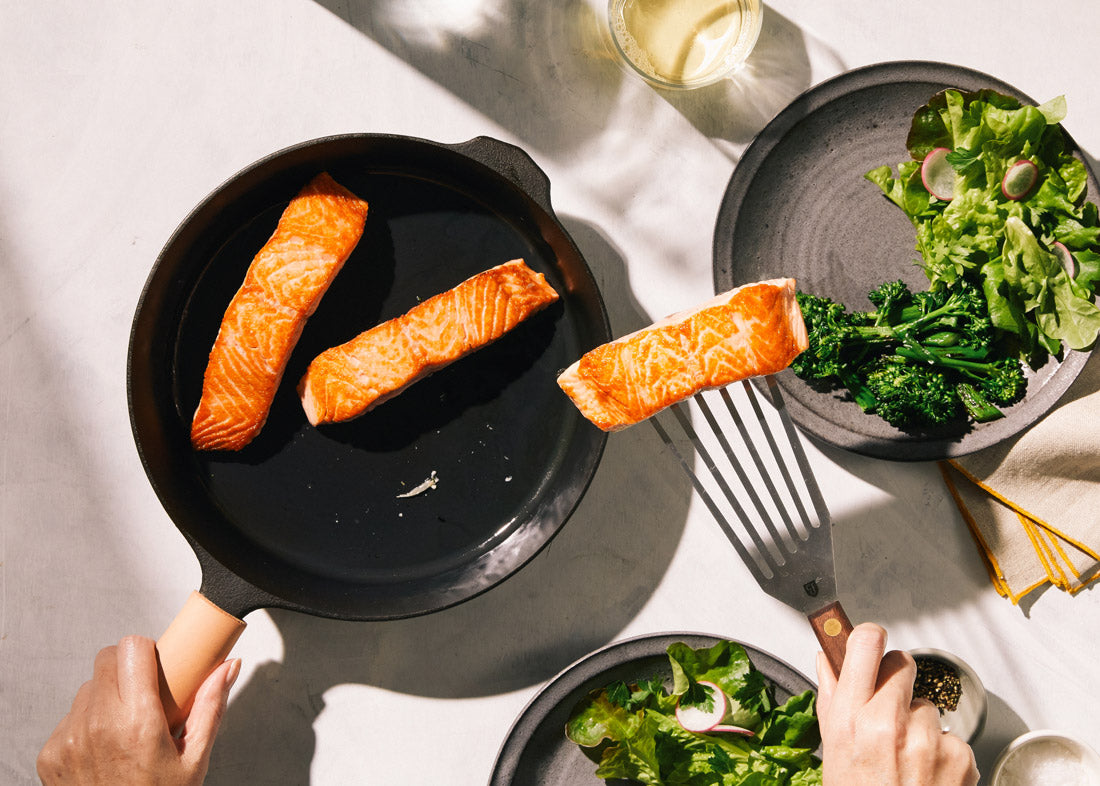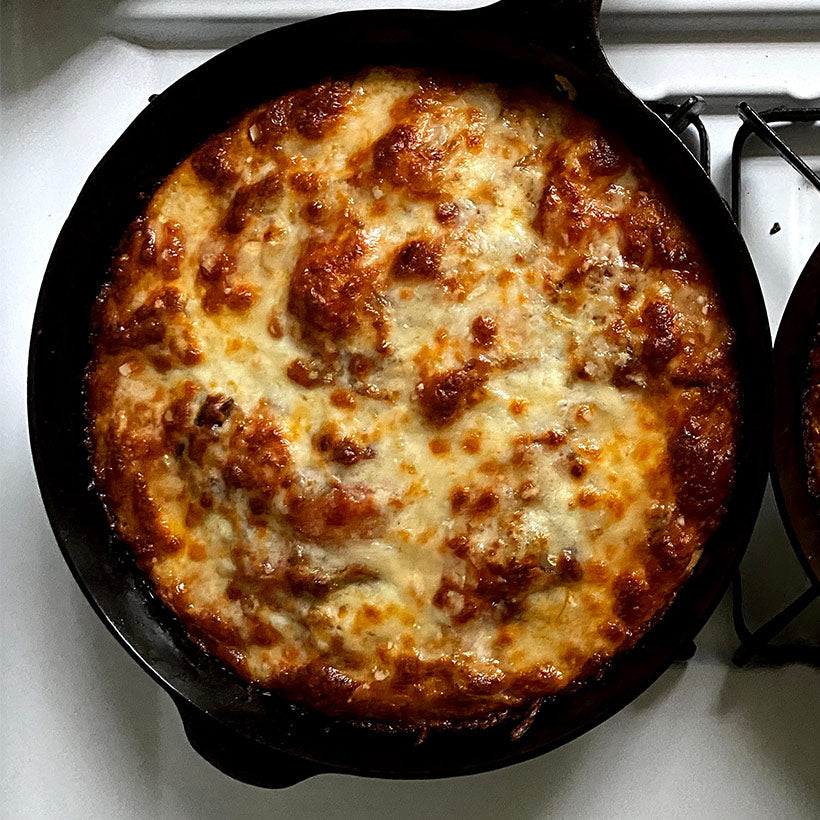

Table of Contents
- Can you cook fish in cast iron?
- Are cast iron skillets non-stick?
- What is the best type of salmon?
- How do I cook salmon in a cast iron skillet?
- Cooking salmon in the oven
- What should I serve with salmon?
- How to clean your cast iron skillet after cooking salmon
There are few forkfuls as satisfying as a bite of expertly seared salmon: Your fork shatters the salty, crispy skin, then slides through the buttery, rosy flesh. It’s the ultimate duality of textures, and you need only one tool—a cast-iron skillet—and a few simple tricks to achieve it. This article will teach you everything you need to know about cooking salmon in cast iron.
Can you cook fish in cast iron?
Absolutely. Cast iron is hands-down the best skillet material for cooking salmon? Why? Because cast iron outperforms all other materials when it comes to heat retention—that is, the metal’s ability to store and maintain the heat generated by a stovetop burner or oven. Once you get a cast iron skillet hot, it stays hot, which helps apply an even sear to salmon and other proteins. This isn’t the case with other skillet materials. When you add a piece of fish to a stainless steel or aluminum skillet, for example, it lowers the pan’s surface temperature, which results in an oven sear and can cause the fish to stick, especially when cooking it skin side down.
Are cast iron skillets non-stick?
Yes. A well-seasoned cast iron skillet is as naturally non-stick as any pan that’s been treated with a chemical-based non-stick coating, and cast iron cookware is far more durable—its nonstick seasoning actually improves with use and age.
What type of salmon is best?
You’ll likely encounter several types of salmon at the fish market or grocery store, and what species you choose to cook should depend mostly on what you like to eat. Do you want a rich, flavorful fish, or one that’s leaner and more mild in flavor? It’s also important to decide if you want a wild-caught or farm-raised salmon, and the nutritional and environmental implications of each. Farmed salmon tends to be higher in fat (as well as omega-3 and omega-6 fatty acids), while wild-caught salmon is leaner with a more pronounced flavor. Both practices can be sustainable, and both can be detrimental to the environment. To learn more about sustainable salmon practices, we highly recommend visiting SeafoodWatch.org, which will help you make the most responsible selection.
Most of the salmon sold in the United States comes from either the Pacific or Atlantic ocean. Pacific salmon is typically caught wild, and common varieties sold fresh are King (or Chinook), Sockeye (or red), and Coho (or silver). King salmon is rich, fatty and flavorful, and often the most desirable variety among chefs (and is priced accordingly). Sockeye salmon has a bright-red color and leaner flesh, with a flavor similar to King (though it costs far less). Coho salmon is medium-fatty with a mild flavor.
Atlantic salmon is always farmed, so the flavor, color, and quality can vary depending on how it was raised. If you’re buying Atlantic salmon, it’s best to source it from a trusted fishmonger who can tell you more about its origin.
How do I cook salmon in a cast-iron skillet?
Not only is a cast iron skillet the best tool for making crispy-skinned, evenly cooked salmon, it’s easy and nearly foolproof if you follow these tips:
Dry, dry again. Fish skin loves sticking to cooking surfaces, especially when it’s wet. Blot the skin of your salmon (or any skin-on fish you’ll be cooking) with paper towels when you remove it from the refrigerator and unwrap it, then repeat right before you season the fish and place it in the skillet. Some cooks like to press a paper towel on top of the skin and leave it there while they heat up their skillet, but we find this actually makes the skin more moist (Think about it: would wrapping yourself in a wet towel dry your body faster than wiping and leaving your skin exposed to the air?).
High, then low. Even if your fish skin is bone dry, it’ll still want to stick to a cold pan. Cast iron is undoubtedly the best vessel for cooking extra-crispy fish, but only if you start with a hot skillet. Preheat your skillet for a few minutes before adding oil (this prevents the oil from getting too hot before the pan is evenly warmed up), then add the oil and heat it until it shimmers like a mirage. Then, immediately after you add the fish to the pan, decrease the heat to low. The gentle heat will both cook the fish more evenly, giving the skin time to evenly brown and crisp.
Press the flesh. When fish skin hits a hot pan, it shrinks and curls in on itself. To prevent this, press down on fish as it cooks with a flexible fish spatula for 10 to 15 seconds at a time, alternating between fillets as they threaten to bow—like a very slow game of Whack-a-Mole. After a minute or two, the fish will relax and stay flat without you needing to press it.
Finish Up. This may sound obvious, but we see this mistake all the time: Once your fish is cooked through, transfer it to a plate—Skin. Side. Up!—and let it rest for a couple of minutes before digging in. Lastly, if you’re serving your fish with a sauce (or even just a drizzle of olive oil), serve it on the side—or below—the fish: any liquid on top of that crackling, fussed-over skin can make all your efforts in vain.
Recipe: Cast Iron-Seared Salmon
Ingredients
Four 6-ounce salmon fillets, with skin
2 tablespoons vegetable or grapeseed oil
Kosher salt
Lemon wedges, for serving
Tools
Resources
The Field Method for Cast Iron Care
Instructions
Heat a cast iron skillet over medium-high heat for a few minutes. Add the oil and heat until it begins to shimmer.
Just before adding the fish to the pan, pat the skin side of the fillets dry with paper towels and season all over with salt. Lay the fish in the pan, skin side down, and immediately turn the heat down to low (this will give you more time to crisp up the skin). Using a spatula, press down on the fillets for 10 to 15 seconds at a time to ensure as much skin-to-pan contact as possible.
After a few minutes, gently nudge the salmon fillets: If they slide around the pan easily, you can start lifting them up with a spatula to peek at the skin below. They’re ready to flip once the skin is golden brown and the flesh is opaque almost all the way through, about 5 to 7 minutes, depending on the thickness of your fish.
Flip the salmon and cook the flesh side for 30 to 60 seconds or until the fish is opaque through (an instant-read thermometer inserted into the thickest part of the flesh will read 120°F to 125°F for medium rare to medium).
Transfer the salmon, skin-side up, to serving plates. Serve with lemon wedges.

Cooking salmon in the oven
Instead of cooking salmon fillets on the stovetop, you can also begin the process at the stove and finish it in the oven. Preheat the oven to 400°F, and follow our recipe through Step 2, then transfer the skillet to the oven until the fish is just cooked through, 8 to 10 minutes.
In addition, you can cook the salmon, start to finish, in the oven broiling it. Preheat the broiler to high and position a rack 4 to 6 inches below the heating element. Lightly brush a cast iron skillet with oil, and place the seasoned salmon fillets, skin-side down, inside. Broil the salmon until the top is nicely browned, 3 to 6 minutes (depending on how your desired level of doneness).
What should I serve with salmon?
One of the best things about salmon is its versatility; it goes with both starchy and vegetable sides, and pairs well with the flavors of most cuisine types. Some of our suggested sides for cast iron-seared salmon are:
Starchy sides: steamed rice or rice pilaf, mashed, roasted, or gratin potatoes, couscous, risotto, orzo, farro.
Beans and legumes: braised beans or chickpeas, lentil salad.
Vegetables: roasted carrots, squash, or Brussels sprouts; blistered green beans; braised cabbage or kale; sauteed zucchini, spinach, or kale; grilled asparagus.
How to clean your cast iron skillet after cooking salmon
Cooking salmon in any type of cookware—including cast iron—can leave behind an unwanted fishy smell, which you risk imparting on whatever you cook next in the skillet. But it’s easy to get rid of any trace by rinsing and drying the pan, then baking it in a 400°F oven for 15 minutes (while you’re at it, you can also apply a fresh coat of seasoningg!).




